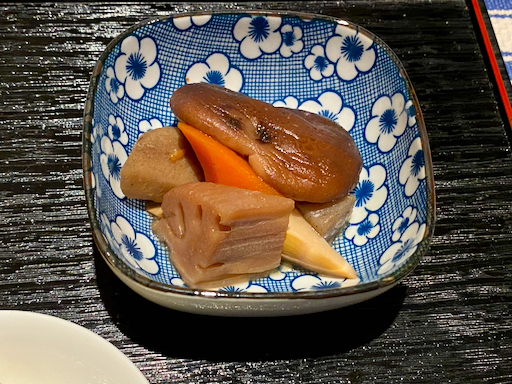Monday, March 13, 2017
Boiled Octopus 煮だこ
As I have mentioned before, this is packed by an American company called PanaPesca (#1). After thawing, I washed (#2) and salted them. I then massaged them vigorously until slim/bubbles developed (#3). I then washed them and repeated the same process several times (in the hope to make it tender). I slowly lowered just the tentacles into a pot of salted boiling water to which a splash of sake had been added holding the octopus body suspended above the water. The tentacles immediately curled up. I then dropped in the rest of the body to submerge it in the boiling water. I let it cook for just 30 seconds and took it out to cool (#4).
In order to make octopus tender it is important to either boil it briefly or simmer it for long time. Although legs were a bit smaller than they should have been for New Year dishes they tasted ok. At least, we had octopus to grace the holiday.
Sunday, January 30, 2022
Octopus rice 瀬戸内海蛸めし
We have been getting Japanese rice from the New York Rice factory. It may be hard to believe (we our selves are somewhat incredulous) that there could be such a difference in something as subtly flavored as rice but the rice from the rice factory is really good. It is hard to identify what sets it apart from the rice we used to get but in general we really like the texture, the taste and especially how well it can be reheated and still tastes like it just came out of the rice cooker.
Whenever I order rice from the rice factory I usually supplement the order with other items. In the past, we got a kit to make “red snapper rice” or “taimeshi” 鯛めし, a type of seasoned rice famous in the Japanese inland sea area or "seto-naikai" 瀬戸内海. Another time I ordered a similar seasoned rice kit made with octopus called “seto-naikai tako-meshi” 瀬戸内海蛸めし. After I bought it, however, the kit sat in our pantry for some time. When I checked the expiration date, it had expired the previous month, so I decide it was time to make it as a shime 〆 or ending dish one weekend. The kit came in several pouches; one with seasoning sauce, one with small bits of octopus, one with freeze dried items. It also included a rectangle of kelp. I made the octopus rice according to the instructions. I served it with a side of simmered Japanese root vegetables I had made and salted cucumber, daikon and nappa cabbage or "oshinko" お新香.
Wednesday, November 23, 2011
Octopus with tomato and olive イタリア風 たこ、トマト、黒オリーブ煮
 In a small skillet, I added olive oil (3 tbs) on low flame and added the garlic, red pepper flakes and slowly cooked it until the garlic became fragrant and very slightly brown. I added the tomatoes, chopped black olive, salt, and pepper. I turned up the heat to medium and cooked for 2-3 minutes (This is not really a tomato sauce). I then added slices of octopus and cooked for 30 more seconds or just until warm--not really cooking it further. I cut the heat and tasted it. I adjusted the seasoning by adding salt and a pinch of sugar since I thought it was a bit on the acidic side. I was thinking of adding lemon juice but changed my mind and only added grated lemon zest (using a micrograter) to give it a lemony flavor. I garnished with chopped parsley (If I had fresh thyme, I may have used thyme). My wife quickly toasted some bread (store bought semolina bread) for mopping up the juice.
In a small skillet, I added olive oil (3 tbs) on low flame and added the garlic, red pepper flakes and slowly cooked it until the garlic became fragrant and very slightly brown. I added the tomatoes, chopped black olive, salt, and pepper. I turned up the heat to medium and cooked for 2-3 minutes (This is not really a tomato sauce). I then added slices of octopus and cooked for 30 more seconds or just until warm--not really cooking it further. I cut the heat and tasted it. I adjusted the seasoning by adding salt and a pinch of sugar since I thought it was a bit on the acidic side. I was thinking of adding lemon juice but changed my mind and only added grated lemon zest (using a micrograter) to give it a lemony flavor. I garnished with chopped parsley (If I had fresh thyme, I may have used thyme). My wife quickly toasted some bread (store bought semolina bread) for mopping up the juice. Wednesday, January 22, 2020
Potato salad topped with squid "shiokara" イカの塩辛のせポテトサラダ
The picture below shows the shiokara topped potato salad. The idea here is that the salty and umami flavors of the shiokara will enhance the flavor of the potato.
The below is the octopus dish. I just sliced the octopus leg thinly on the diagonal in a wavy pattern. I put the daikon namsu on the bottom of the small bowl and put the cut octopus on top. I have been making a few Japanese sauces and storing them in the fridge in small squeeze bottles. I squeezed some sumiso sauce that I made few days ago on top of the octopus. (Having these pre-made sauces ready in squeeze bottles is very convenient).
The potato salad shiokara combination is not bad but we both felt enjoying the potato salad and shiokara separately may be better. As my wife put it, "the purity of the shiokara flavor and the purity of the potato flavor are best experienced individually and in their own right." Thus sayeth a shiokara purist.
Saturday, October 29, 2022
Tako rice and Matsutake soup for lunch タコ飯と松茸のお吸い物昼食
This was a lunch we had one day. We had leftover frozen octopus rice or “Tako meshi” たこめし made from a kit we got from the Rice factory. Although the original was not bad, the amount of octopus was rather small. Since I made tender simmered octopus タコの柔らか煮 a few days ago, I added slices of octopus legs to the previously made rice. Also we had matsutake mushroom 松茸 from Maine and made clear matsutake soup 松茸のお吸い物. I added a dish of salted vegetable or “asazule” 浅漬け and simmered root vegetables and chicken similar to “Chikuzen-ni” 筑前煮.
Tuesday, July 26, 2011
Octopus and Nagaimo stir fly with garlic 長芋とタコの塩バターソテー
Wednesday, September 25, 2013
Tako grill in Kuroishi, Japan 青森黒石, 蛸俱璃瑠タコグリル
Chef Kudo opened a new Izakaya/Sushi bar and creatively named it… “Tako Grill”. The place is very spacious with light wood inside. A wide wooden counter with his working area immediately behind and the kitchen is hidden from view by a purple “Noren” のれん. He and his help were wearing the same Tako grill T-shirts and the cover of the menu is also the same as one in Bethesda (although Kudo did not offer the menu and we did not need it as he served what was the best and what we would like).
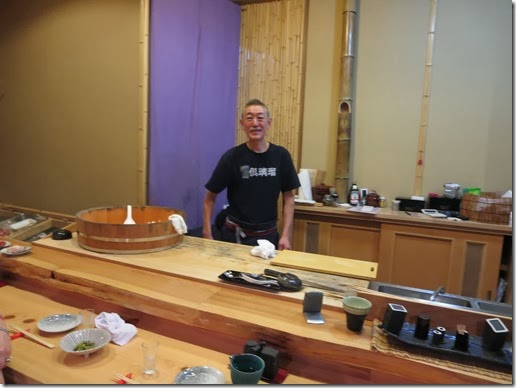
He looked the same but a bit thinner. For sake, Kudo offered the local sake from Kuroishi; Kikunoi Honjozo Genshu “Akiagari” 菊乃井 本醸造原酒 ”秋あがり”. This was a nice dry crisp unpasteurized genshu sake with lots of “umami” flavors. We liked it very much.
As we engaged in some catching up, he started serving us a series of excellent dishes. Otoshi お通し was a small local vegetable somewhat similar to small “fuki” ふき but we were told that this was a totally different local vegetable (I do not recall the name).
Sanma さんまor Pacific saury, sashimi was the best we ever had.
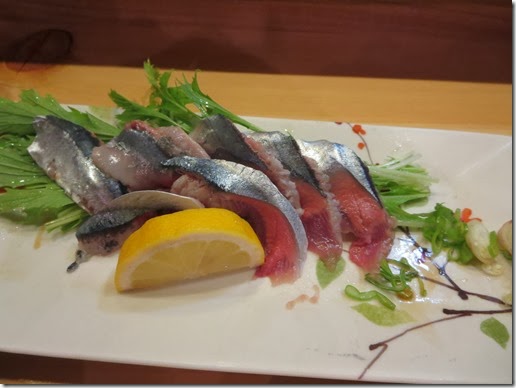
Okoze オコゼ or stonefish was the next offering. This is a rather unattractive looking fish from which he carefully removed the venomous dorsal fin (picture below) and then deep fried. we enjoyed the whole fish; bone, head and all.
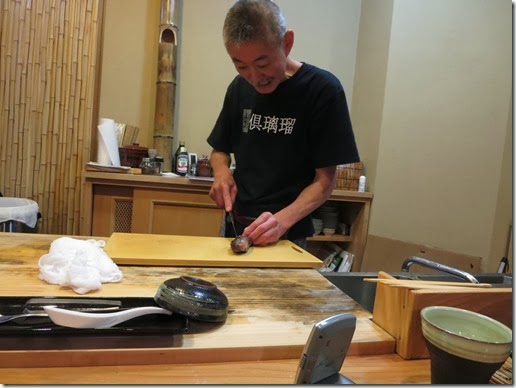
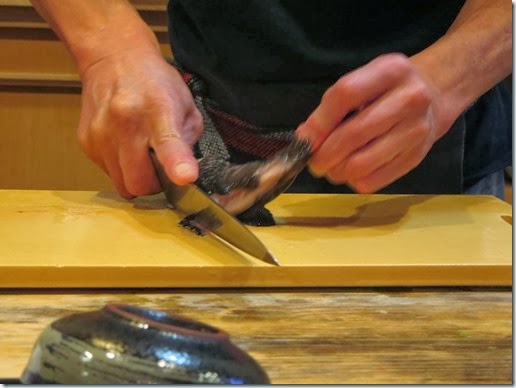
Since this was “Tako” grill, we had to have “Tako” 蛸 or octopus. Kudo first offered us slices of octopus legs with “sumiso” 酢味噌 dressing. Somehow, the quality of the octopus was different from what we usually get in the U.S.; it was succulent and soft not rubbery or chewy. Then he took out the fresh octopus leg saying this leg was still alive and prepared for us fresh “tako no sashimi” 生蛸の刺身 (below picture). As he slapped each slices down, the muscle contracted. We have had fresh octopus sashimi before in Kobe 神戸 but this one was totally different. The one we had in Kobe was slices of the leg and had a very soft consistency but this one appeared to be the suckers (skin carefully removed) and had nice firm consistency and sweet taste. We were already on the second round of sake.
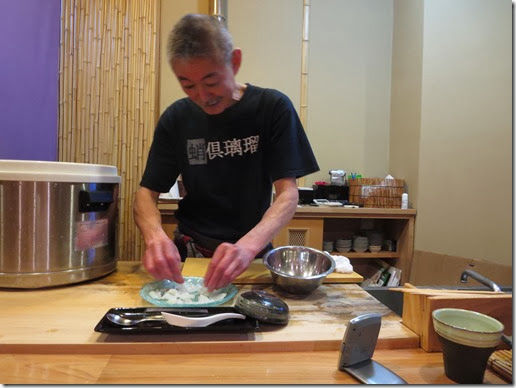
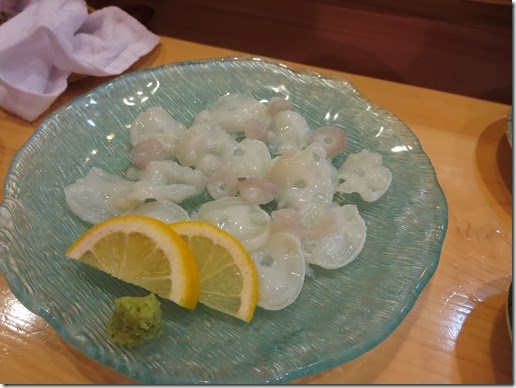
Our memory was getting fuzzy around this time forward but we had grilled and straw “wara” 藁 smoked sanma. We usually do not like innards but this was an exception. The sanma was fresh to begin with and the way this was prepared was great. Nice smoky flavor and the bitter taste of the sanma innards were perfect combination between the sips of cold sake. We also had a local nice large succulent oysters. What a treat!
Then came the “Piece de resistance”. We discussed the great things Kudo served us at Tako Grill in Bethesda and mentioned “squid okizuke” イカの沖漬け he had served us one time and how much we loved it. Without a pause, he wheeled out a container with fresh “squid innards” okizuke he had prepared (below). Actually, the first serving was consumed so quickly between my wife and I that I did not have a chance to even take a picture. Kudo gave us the second serving and we managed to restrain ourselves long enough to snap the pic.
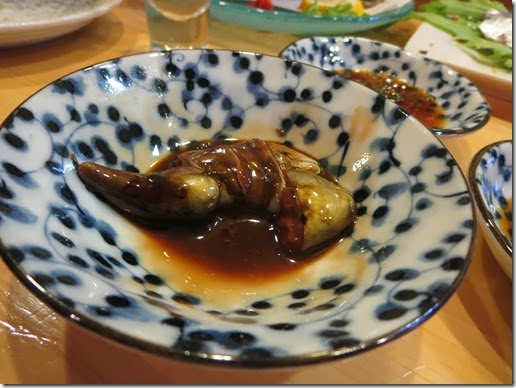
At this point we were quite full and feeling full effects of the sake. He served us a few pieces of nice nigiri. He then joined us with a glass of his own sparkling sake and we chatted. He appeared happy to be back to his furusato 故郷 (home town).
Finally we had to say good night. He called us a taxicab and we went back to our “hotel” called “Takara onsen” 宝温泉meaning “Treasure hot spring”. Kudo arranged our stay there. This is the first time we had a room with our own private “onsen” attached running steaming hot water 24/7. But this is a long and separate story to tell.
We are glad we visited Tako grill in Kuroishi. We wish Kudo all the best. With food that great, he should prosper and we can visit him again in the near future.
Wednesday, August 5, 2015
Octopus 2 ways たこのお通し2種類
The first one is sort of octopus carpaccio (Carpaccio de pulpo). I posted a similar item in the past. I first made zigzag lines of good fruity olive oil on the plate and then criss-crossed with lines of syrupy aged balsamic vinegar. I scattered Kosher salt and freshly ground black pepper. Since I had a leftover fennel bulb which was used for making chicken paillard, I first thinly sliced fennel using a Japanese mandolin Benriner and placed them as a base. I thinly sliced boiled octopus leg and placed in one layer on the top. I added a few slices of fennel, thin slices of cucumber and scattered oil cured back olives (after removing the stone). I finished with lines of olive oil and balsamic vinegar, Kosher salt and black pepper. Fennel added anis-like flavor and oil cured olive gave a burst of saltiness. This combination was quite good.

Using the tips of the octopus leg, I also made a small Japanese style salad with karashi-su-miso 芥子酢味噌 dressing. I just cut the tips into small bite size chunks. I sliced cucumber, salted it and squeezed out the moisture. I then took salt preserved (not dry) Wakame sea weed, washed it to remove the salt and soaked in water for a few minutes then cut into small pieces. The dressing is a mixture of white (sweet "Saikyo" 西京味噌) miso, rice vinegar, Japanese mustard and sugar.

Because of the acidity in the dishes, sake was the best choice although the first Carpaccio dish could go with wine. These were good starters with cold sake.
Thursday, January 28, 2010
Rare tastes 珍味
Dried "Shishamo" fish 寒干しししゃも
This small fish called "Shishamo" ししゃも or 柳葉魚、Spirinchus lanceolatus, is harvested only on the southern pacific coast of Hokkaido. I grew up with this fish and they are very popular drinking snack items especially in Hokkaido. These are usually semi-dried and we get them frozen in the United States. My mother sent these to us. They were (supposedly) "fully dried" in the cold northwind of Hokkaido. They can be eaten as is but I grilled them briefly over the gas fire and served them with grated daikon 大根おろし and soy sauce. They are a bit chewier than semi-dried (which has to be more thoroughly grilled) but they are very flavorful. To my surprise, even my wife liked them.
Raw Octopus marinated in wasabi sauce たこぶっかけ (lt)、Salmon roe with grated daikon いくら甘酢大根おろし (ctr)、Raw Squid mariated in hot red peper sauce イカぶっかけ (rt)
In the above image, from left to right are raw octopus with wasabi sauce たこぶっかけ、salmon roe with grated daikon いくら大根おろし (grated diakon is seasoned with sweet vinegar which is only item I prepared)、and raw squid with hot sauce イカぶっかけ. These squid and octopus dishes are variations of "shiokara" and "okizuke" and are called "bukkake" ぶっかけ in which small pieces of raw octopus or squid are marinated in a spicy sauce. Here, the octopus is marinated in "wasabi" sauce and squid in red pepper sauce. Both come in a small plastic pouch and bought frozen. These are perfect accompaniment for sipping sake.
Cheese stuffed squid チーズいか
Smoked scallop 帆立ての薫製
Friday, November 25, 2011
Sautéed octopus, mixed mushroom in sherry sauce 蛸ときのこのシェリー酒ソース
Thursday, July 14, 2016
Pulpo al ajillo タコのアヒージョ
I seasoned it with salt and pepper and added finely chopped parsley. Even off the heat, the olive oil kept boiling for a few minutes. I served this with thin slices of my freshly baked baguette. Yes this was very good. The bread mopped up the wonderful garlic olive oil sauce. The octopus was chewy but tender.
It is interesting to know that, when I searched for a similar recipe while writing this post, I only found recipes in Spanish. When I searched this in Japanese as "タコのアヒージョ", there were many recipes in Japanese. In addition, I found many Japanese variations. In any case, this was a perfect dish for the evening. The only problem is because of the bread this dish was quite filling.
Saturday, April 20, 2013
Octopus sashimi Wasabi flavor with apple and olive oil 蛸のわさび漬け、リンゴとオリーブオイルいり

I defrosted a package of "Tako wasabi-zuke" たこわさび漬け (picture below left, the price is for two packages). The picture, below right, shows what it looks like once thawed.
I just diced an apple (Fuji apple) mixed it in, splashed on a good fruity olive oil and garnished with finely diced jalapeño pepper (seeded and de-veined).

My wife thought my concoction was better than what we had at "Daikaya". It has a nice yuzu-wasabi flavor and the pieces of raw octopus were much larger with a much nicer texture. (Maybe because of the difference in size and texture of the pieces of octopus in our dish, they did not stick between our teeth like the ones in the dish at Diakaya). It was a good idea to add the crunch of apple and the nice fruity olive oil flavor to this type of dish but I'm not sure I would call this "cooking".
Friday, September 13, 2013
Grilled skewered octopus 鮹(の串)焼き

I thinly sliced the thickest potion as “sashimi” (left in the above picture) and cut the rest into sizable chunks. I skewered them (I prepared two skewers) and grilled them in the toaster oven on broil for about 5 minutes turning once. As you can see some of the edges got slightly charred. Besides soy sauce, I also made “Karashi sumiso” からし酢味噌 from “saikyou miso” 西京味噌.
The sashimi was very tender and excellent. As to "takoyaki”, we are not sure. Grilling made it a bit more chewy and warm but appeared not to add anything more. We prefer just simple “Butsugiri” seasoned with “karashi sumiso” but we need to visit this place called “Akita-ya” 秋田屋 in Hamamatsu-chou 浜松町 in Tokyo and try this before passing on the final opinion.
Tuesday, November 24, 2015
Sautéed baby octopus タコのソテー
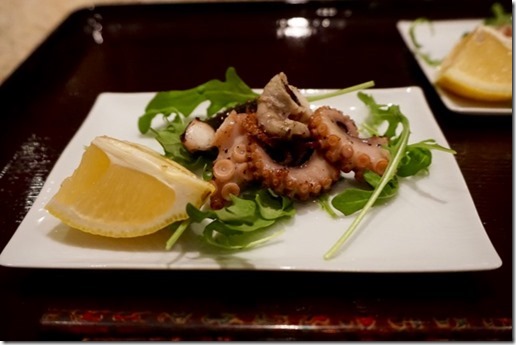
I washed and salted the thawed guys. I kneaded them in a metal bowl in an attempt to tenderize.
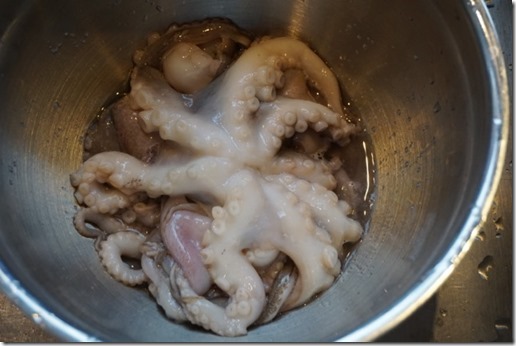
I then boiled them in water with added salt, sake, and a small splash of rice vinegar for 30 minutes on low heat.
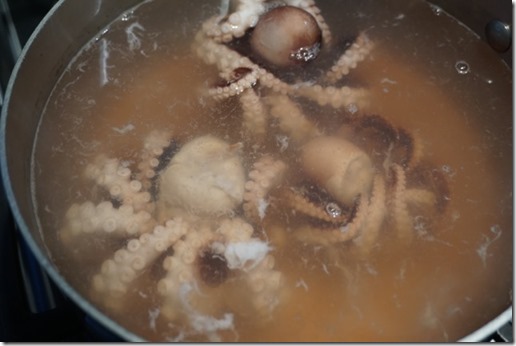
After 30 plus minutes, the octopus shrank quite a bit.
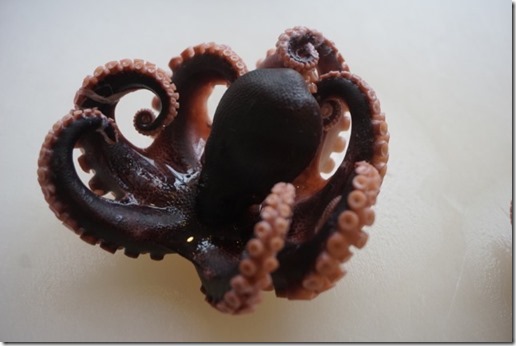
I cut two into several long pieces and placed then in my oden pot and simmered for 1 hour or so with other oden items. This was very tender and nice. The remaining one, I cut into bite sized pieces, placed them in a ZipLoc bag and added olive oil. I kept this in the fridge for a few days before we got back to it. I simply sautéed it in olive oil and seasoned it rather severely with salt and freshly ground black pepper.

The octopus was very tender and the flavor profile went well with wine. If I find a similar package again I will definitely buy one but so far I have not seen this item in the Japanese grocery store.
Saturday, March 7, 2015
Tako Yaki たこ焼き
One of the reasons I made takoyaki was because this gave me another post but also because of my sister-in-law gave me an electric ebelskiver cooker as a Christmas present. After several of the cookers were delivered by Federal Express Ground to random locations other than our house it finally arrived last week—only 2 months late for the Christmas holiday. When I saw the cooker all I could think was Takoyaki. The size of the cooking wells and resulting product were larger than traditional Takoyaki but my wife said, “just call it American style takoyaki.
I made a takoyaki sauce and garnished with bonito flake powder and "aonori" 青海苔. For the first try, this was good with a crunchy outside and molten soft inside centered with a piece of boiled octopus leg.
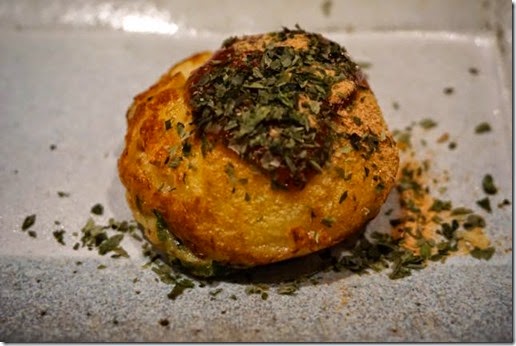
Since this is not a type of food I grew up with, I looked for an authentic recipe for takoyaki. After looking through various recipes, I settled for the recipe which was written in Osaka dialect (a true sign of its authenticity).
Ingredients:
Takoyaki sauce: A mixture of Lee and Perrin worcestershire sauce, ketchup, and honey. The ratio of the Worcestershire sauce and ketchup is about 1:2 and honey to your liking of sweetness. The authentic sauce is supposedly rather sweet. Among the pre-made commercial sauce, Otafuku brand takoyaki sauce おたふくたこ焼きソース is most popular. (left, upper).
Boiled octopus leg: I just cut into 1/2 inch or 1cm chunks (I made 12) (right lower).
Scallion: Finely chopped about 4 stalks (left lower) (1 tsp per ball).
Tenkasu*: See picture and write up below. (1/2 to 1 tsp per ball).
In terms of the garnish, I prepared dried "aonori" (upper right) and dried bonito powder (middle right, I made bonito powder by grinding the bonito flakes in a Japanese mortar and pestol (suribachi すり鉢) but this is not necessary (use as is).
I did not use additional items such as red pickled ginger (紅生姜) or small dried shrimp (桜エビ). According to this recipe, adding shredded cabbage is totally not authentic. If used, it should be called "Okonomiyaki" ball rather than takoyaki.
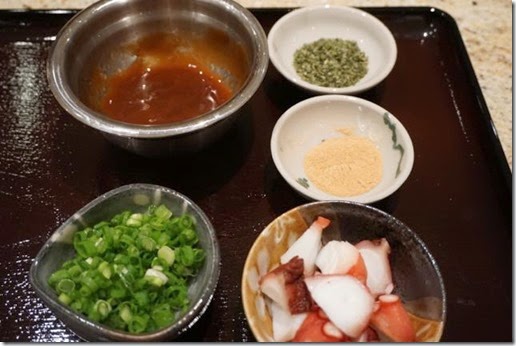
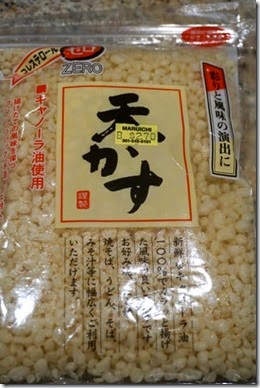 *Tenkasu: One more ingredient I needed was "tenkasu" 天かす or "agedama" 揚げ玉 a by-product of making tempura. They are the small fried tempura bits of batter that come off the main tempura while it is being cooked. They are quickly removed from the oil before they burn. Besides being used in making takoyaki and okonomi-yaki, they can be used as a topping for noodles (such as in "Tanuki" udon or soba), miso soup and other dishes.
*Tenkasu: One more ingredient I needed was "tenkasu" 天かす or "agedama" 揚げ玉 a by-product of making tempura. They are the small fried tempura bits of batter that come off the main tempura while it is being cooked. They are quickly removed from the oil before they burn. Besides being used in making takoyaki and okonomi-yaki, they can be used as a topping for noodles (such as in "Tanuki" udon or soba), miso soup and other dishes. Interestingly, in Hokkaido they are more commonly called "agedama" or "fried balls". This is a term I prefer to Tenkatsu which literally means "wastage or scum" of tempura and does not sound particularly appetizing to me. They used to be discarded or given away free at tempura or soba restaurants but more recently, packaged commercial products can be had (some even flavored by ground up dried shrimp). I could have made this myself but for takoyaki, I bought pre-made one, as seen on the left, at my Japanese grocery store.
The advert on the package boasts of supposed health aspects of this otherwise unhealthy product. The package indicated it was healthy because it was fried in Canola oil and 0% cholesterol (same in any other vegetable oil). Maybe this is better than if they were fried in tallow but the distinction seems slim to me. I see similar amusing claims on potato chip packages touting how healthy they are. In any case, surprisingly they were not oily and had no smell or taste of oxidized oil but, by the same token, they had no flavor whatsoever, only texture. We were not sure this added anything special to our takoyaki (I added about 1 tsp per ball).
Batter: The batter is most important. I like this recipe since it was proportional based on the numbers of eggs used. The important things seem to be; 1. Use a good quality cake flour, 2. Liquid and flour ratio is 1:4 to 1:4.5 (some recipes call for 1:5 ratio), 3. Use of powdered skim milk and baking powder (They are recent additions and improve the quality of takoyaki according to this author. He referred to these additions as "progress"). I really liked this approach so I translated his chart below.
| Numbers of takoyaki | Cake flour | Powdered milk | Baking powder | Sugar | Salt | Soy sauce | Dashi broth | Eggs |
| 20 (12*) | 70g | 1 tbs | 1/2 tsp | 1 tsp | 1/4 tsp | 1 tsp | 300cc | 1 |
| 40 | 140g | 2tbs | 1 tsp | 2 tsp | 1/2 tsp | 2 tsp | 600cc | 2 |
| 60 | 210g | 3tbs | 1.5 tsp | 3tsp | 3/4tsp | 3 tsp | 900cc | 3 |
I made the smallest amount (i.e. using one egg). This amount should make 20 takoyaki but with my American style takoyaki/ebleskiver cooker, I could make only 12 since the diameter of the wells are 5.5cm as opposed to either 3.5 or 4.2 cm of authentic takoyaki grills. I think the size difference is not a problem, at least for us. I used about 10cc of 1% milk since I did not have powdered skim milk and reduced the dashi by that amount. The dashi was made with kelp and bonito flakes as usual. I did not sift the flour (which is recommended) but added the cold liquid into the dry ingredients gradually as I whisked. It made a rather thin batter. I let it refrigerate for several hours before using.
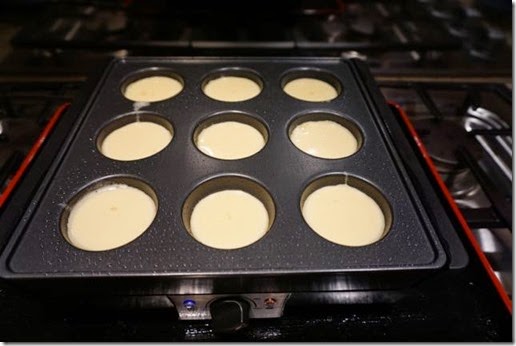
After few minutes the edges started bubbling and I added the octopus leg (below).
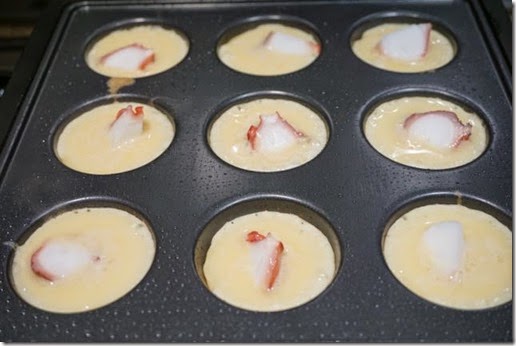
I then added the scallion (about 1 tsp) and the tenkatsu (1 tsp) and topped it off with more batter (see below).

Using the bamboo skewer and the special sticks came with the ebleskiver maker, I tested if the bottom was set and started turning them over (below).

I turned them over few more times to make all the surface equally brown (see below).

The center should be still molten (as I was told) so I declared these done.
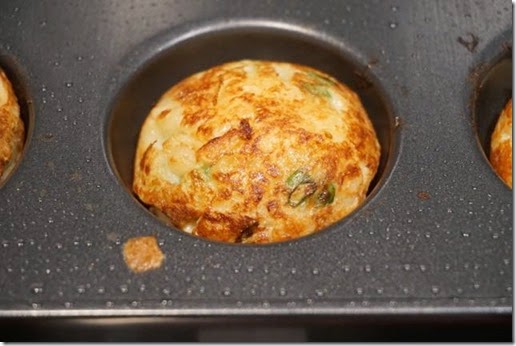
I brushed a small amount of my takoyaki sauce (mine is not as sweet as real Osaka style but I thought it was good. My wife said the sauce made the dish.) I then sprinkled on a pinch of the bonito powder and aonori powder (the first picture).
The center was very hot and molten. My wife thought that, instead of octopus leg, we could use shrimp (which I agree but then it will not be called takoyaki—maybe ebiyaki?). Another natural variation would be the addition of cheeses. Since I made "authentic" takoyaki, I may experiment with more variations (of course, I may consider making ebleskiver as well). We made total of 12 (9 in the first batch and three more). Between two of us, we finished all 12 in no time.






